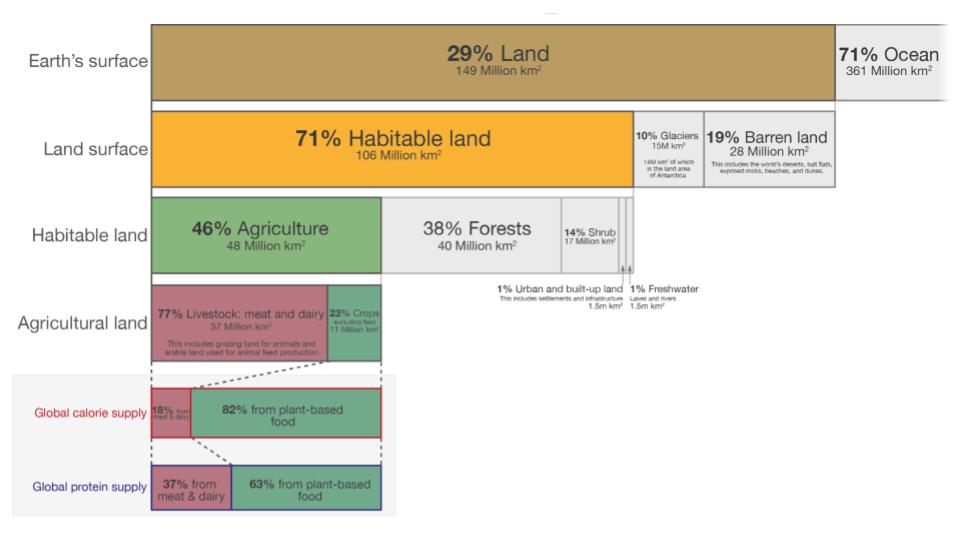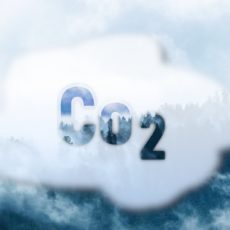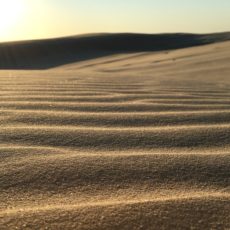
Whenever we talk about the Climate Crisis, the first issues which usually come up are global warming, our carbon footprint and living without fossil fuels, trying to transition to renewable energy instead. But one of the biggest impacts we have on this planet, which also happens to have one of the quickest wins associated with appropriate solutions, is land management.
This isn’t a reference to the destruction of rainforest – that is definitely on people’s radar. This is about the use of the land after there’s been some form of deforestation. Whether that’s for animal agriculture, crops, or building settlements for us. The way we carry out those activities is hugely impactful on the planet. We can choose to make that impact negative or positive in the long term.
The negative end of that spectrum is land degradation. Which is defined as a process which leads to the deterioration or loss of the productive capacity of the soils for present – and future – use. There is an overall reduction in biological activity within the soil, which is necessary for fertile and productive land. The causes of land degradation can be either natural or human. Some of the natural influences, like landslides, might be wholly and genuinely natural. While a human induced cause is over tilling, for example. Or the cause might be linked to us through the impacts of the climate crisis, like increasing frequencies and lengths of drought periods. But even landslides are increasing in frequency in some parts of the world due to increased heavy dumps of rain in short periods of time. Yes, a symptom of the climate crisis.
Land degradation can take the form of soil erosion; desertification; salinization; soil acidification or alkalinization; and soil pollution from chemicals. And all lead to reduced productivity and biodiversity.
As land use is the main reason for widespread land degradation around the globe, let’s look at what land is used for. 29% of the earth’s surface is land. Of that, 71% is habitable land. 46% of our habitable land is being used for agricultural purposes. That’s higher than the areas taken up by forest. You know, forests which sequester over 7 billion metric tons of CO2 per year, making them an invaluable carbon sink! But back to agriculture: 77% of agricultural land is used for livestock. And livestock production, on industrial levels, uses techniques which are not sustainable for the land. Take a look at our discussion on Regenerative Agriculture – an accessible and necessary alternative to industrial ag. While agricultural development contributes to food security, unsustainable agriculture increases ecosystem and human vulnerability. There is competition for land and water resources. And subsequently land degradation.

Right from removing forested land to install ag, and including every decision the farmer makes about how they’ll grow their crops or livestock, the potential to increase the damage to the land grows. Through tilling, overgrazing, use of excessive fertilizers and poor irrigation management, agriculture is feeding us in the short term but causing risks to that continuing in the long term. Soil health deteriorates over time if it’s not cared for. The result is not only reduced yield, but also reduced nutrients within the crops. This will eventually impact everyone. But at the forefront are local and Indigenous communities who have only themselves to rely on for their food production. And let’s not forget that soil is an essential carbon sink, but the poorer the quality of soil, the less effective it is.
What can we do about this? We need to be smarter about the use of the land. Governments and policy makers must heed the warnings of the past decade about the severity of land degradation. They must then severely limit further agricultural expansion. Farmers must use sustainable farming practices, which can play a huge positive part in land and soil restoration, quite rapidly. And consumers must choose food more wisely. In a recent study looking at historical data, it was found that our food production cycle accounts for 35% of global carbon emissions. Of those emissions, a disproportionate 57% is attributed to animal products. This data was drawn from all over the globe, 171 crops and 16 animal products – fair to say then, it was extensive research. Producing just 1kg of beef causes 70kg of emissions. It’s crystal clear: we need to eat less meat. If we all ate the diet of the average American, we’d need to convert ALL habitable land to agriculture…and we’d still be 38% short. Looking at this another way, despite the fact that land use for animal agriculture far outweighs the use for crops (77% Vs 23%), it provides only 18% of global calories and 37% of global protein. So that just doesn’t make much sense.

If we don’t change the way we think about and care for the ground beneath our feet, humans will face dire food insecurity before the end of the century. And that won’t be the only land degradation related issue.
We know you’re doing what you can to be more sustainable, but based on this new info, why not try at least one extra day per week without meat? It WILL make a difference!



